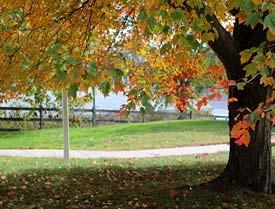 The colors are not as vibrant this fall. It takes very cold nights followed by warm sunny days for the best colors. A combination of drought and heat has kept this year pale.
The colors are not as vibrant this fall. It takes very cold nights followed by warm sunny days for the best colors. A combination of drought and heat has kept this year pale.
However, no matter our perception of their color intensity, they turn lovely colors, and then they fall. And they pile up all over the yard and just laugh, waiting for us to pick them up.
What to do with the falling leaves. In the past, a big pile and then a big bonfire was part of fall. Now that is a No-No, and could cause big fires, which is why my grandfather’s generation stopped them. Even though most land was open farm or pasture, not the unkempt fire danger forests we have today.
Now we compost what we have room for. We collect what we don’t have room for, and good towns with kind garbage compost pickup takes it away. Bless them.
 I don’t rake up the leaves under my bushes or in my groundcover. Mother Nature composts for me and provides a nice spring mulch. I also have a big messy leaf pile and even a composter.
I don’t rake up the leaves under my bushes or in my groundcover. Mother Nature composts for me and provides a nice spring mulch. I also have a big messy leaf pile and even a composter.
Composting is very “in” these days. But it is not so simple. Making good compost is like making good minestrone soup. What you put in, and in what proportions, determines what you get.
1. The University of Massachusetts Extension Service suggests the Brown and Green Method. Browns (high in carbon) are leaves and needles. Pine needles make the compost more acid. Greens (high in nitrogen) are green plant parts, kitchen scraps (no meat or fat), coffee grounds and livestock manure.
2. However, CAUTION! Never put in plants that have diseases, fungus, bugs, or spots. Particularly, never add rose foliage, peony, tomato plants, or vegetables that you plan to grow next year.
3. The best mixing ratio is 3 parts Brown to 1 part Green. However leaves all alone, will compost too. They just take longer. Some leaves compost quickly, some slowly. Maple leaves left on the ground make a wet mat in spring. Also very slow are oak and beech. Beech leaves should be left on the ground under the trees to supply the right microscopic organisms to keep the roots healthy.
4. Compost is a soup of millions of microscopic creatures: starting with bacteria, fungi, and going to numerous unspellable life forms that make the soil more fertile. To incorporate these into your leaves, scatter a shovelful of dirt on each layer.
5. Make sure each layer is wet. UMass says like a wrung out sponge. To speed composting, turn the pile frequently.
The best place, I think, to compost is behind the garage where you don’t have to look at it, while Mother Nature makes her soup. It can be a big pile, or a neat fenced bin. When the leaves compost, they shrink. Two feet will become just inches. Then you can just use it as a nice mulch or dig it in to enrich the soil.
Ruth S. Foster is a landscape consultant and arborist.
Credit: Ruth S. Foster




























